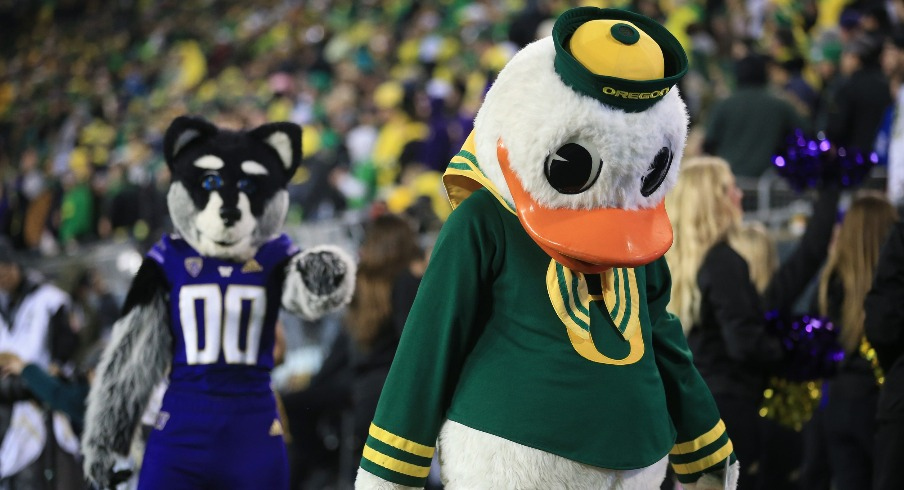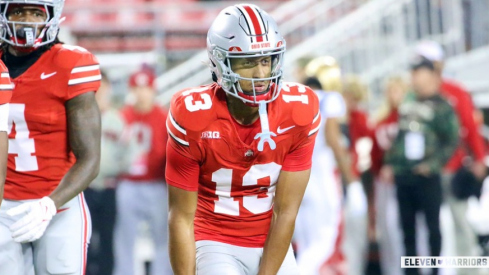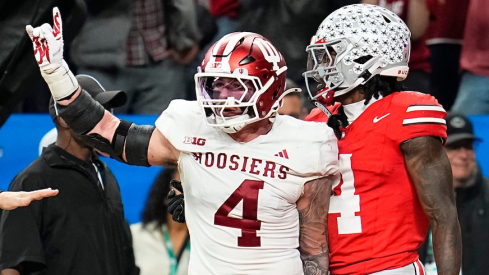The 2023 season will be the last hurrah of the college football traditionalist.
A fan clinging to the old guard could be forgiven if the last two years of the whirlwind college football realignment news cycle has driven them to bury their head in the proverbial sand and pretend it’s just a bad dream.
That’s all the more reason to savor the coming months ahead of us.
Traditional college football will begin its farewell tour this fall starting with Week Zero on Aug. 26 and culminating with the national championship in January. Sure, it’ll be a little weird that BYU, UCF, Cincinnati and Houston are now competing in the Big 12, but the heart of the 2023 season will more or less be the same than you’ve been accustomed to the last 10 years.
Your favorite conference bowl tie-ins will still exist for the most part, leading to unique end-of-season matchups. College football’s playoff will be for only four teams, each with fewer than two losses. The regular season’s end will boast arguably the greatest few days in sports, college football’s rivalry week, where a win or loss can make or break a season.
Once a champion is crowned, buckle up for 2024, because there’s soon to be a new world order in the sport. Like most drastic changes in life, it’s a bit bittersweet. There’s some good, bad and downright ugly with the never-ending tidal wave of realignment. Which of the three is most pertinent depends on each individual fan and their own preference on how they consume the sport.
If you root for Ohio State, Alabama or Georgia, this could all be pretty great. Align with a team getting left behind by TV networks, such as Oregon State, Washington State, Stanford and California, and you’re already likely punching air and questioning the meaning of life over a few adult beverages.
So, what exactly are we in for with college football’s new world order?
The Good
Matchups will undoubtedly be better in the long run
Even before the addition of Oregon and Washington, the Big Ten had already released its new scheduling model. Each team in the conference is guaranteed to play every other school at least biannually, so a four-year athlete would theoretically compete in every single Big Ten stadium by their graduation.
We’ll see if that can still be implemented with two more schools thrown in the mix, but if a college football genie came to the average fan and asked if it would rather see Ohio State be guaranteed to play Rutgers yearly, or instead, play Rutgers one year and the next face off against either Oregon, Washington, USC or UCLA, which option do you think most are going to pick?
The addition of the Pac-12’s four top brands no doubt creates a more appetizing palette of games for college football fans in any given week. Just imagine an October Saturday slate where Michigan faces off against USC, Penn State clashes with Washington, Ohio State and Oregon take to the gridiron and Wisconsin faces Michigan State. Hard not to raise an eyebrow with intrigue, eh?
It’s also exciting to speculate where scheduling could be headed in the future as the SEC and Big Ten each adopt what is essentially a semi-pro model.
No disrespect to Youngstown State and Western Kentucky, but as conferences keep growing larger, wouldn't it be cool to see a scheduling model that sees Ohio State play a full 12-game schedule consisting of its peers instead of less appetizing matchups?
More meaningful postseason games with fewer opt-outs
If there’s any gripe of the old college football regime that merits consideration, it’s that every non-playoff bowl game has gotten watered down to some degree thanks to a flurry of opt-outs from NFL draft-eligible prospects. It’s hard to blame an athlete for preserving his value in a ruthless sport, but a Rose Bowl without a team’s starting quarterback just doesn’t have the same luster.
Well, now that the traditional New Year’s Six bowls are aligned with the soon-to-be 12-team College Football Playoff, each of them is given equal importance on a national scale and no otherwise healthy player is going to pass up on a chance to compete for a national championship.
More meaningful games in November
Picture this.
It’s the second-to-last week of the regular season. Penn State and USC are prepared to lock horns, each with two losses apiece. Under the current format of college football, that matchup would only help determine the pecking order of non-playoff bowl games for those schools. Now, it could be a battle to determine which school earns a CFP spot.
One of the worst (or best, depending on who you ask) things about college football in its current state is one loss has your team on the brink of missing the playoff. Two losses have those hopes dashed completely.
Well, not anymore.
Colleges, at least those competing in the Power Five (err, four?) will have a little more room for error than in previous years, which is bound to keep the interest in the sport up for more fanbases and perhaps some of the otherwise more casual fans. Midseason and late-season matchups that don’t involve undefeated teams could now be all the more intriguing as teams fight for the final few at-large selections.
And that doesn’t factor in the stakes being raised even higher if a team can fight its way to its conference championship game. Under the current model, some conference championships can be exciting while others are a complete waste of time. There’s no denying every single conference championship matters in the new rollout, with the six highest-ranked conference champions all earning playoff berths.
New destinations exciting for traveling fans
It’s not uncommon for football-crazed families to plan one trip a year around a marquee Ohio State game. The Buckeyes now regularly appearing in Los Angeles, Eugene and Seattle give fans some pretty appealing travel destinations — not to mention a chance for warmer weather.
Plus, with a fanbase as large as Ohio State’s, not every fan resides in Ohio. Four West Coast teams joining the Big Ten next fall may have essentially been a jackpot for a die-hard OSU fan living in Los Angeles now that the Buckeyes are guaranteed to be in town at least once every couple of years.
Colleges can still schedule meaningful rivalry games
Aside from the demise of the Pac-12, probably the biggest criticism from fans about the realignment wave has been the presumed death of historic rivalries.
Does Washington bolting mean no more Apple Cup with Washington State? What about Oregon vs. Oregon State?
Well, breaking news: There’s no rule that says you can’t continue that longstanding game because one team switches conferences. Oftentimes when a traditional rivalry is discontinued, it’s purely out of pettiness (looking at you, Kansas and Missouri), not because the logistics are no longer tenable.
There’s plenty of examples of in-state schools facing each other yearly despite different conference affiliations. Iowa and Iowa State. Kentucky and Louisville. South Carolina and Clemson. Florida and Florida State. You get the point.
To Washington and Oregon’s credit, both schools have publicly said they hope to continue their yearly matchup with their left-behind former conference foes. One can only hope for the fans’ sake the games continue.
But while you can salvage some rivalries nixed by conference shuffling with creative scheduling, it’s not going to save every desired regional matchup…
The Bad
Some savored games will no longer be yearly
Outside of Ohio State playing Michigan, the Buckeyes taking on Penn State has been one of the most highly-anticipated games circled on the calendar for avid OSU fans. That’s only going to happen every other year now, not yearly, as OSU’s only protected rival under the new Big Ten scheduling model is Michigan.
Ryan Day and James Franklin can minimize the impact of not clashing annually all they want, but the fans are the biggest ones that will miss out on it.
It’ll also be a bummer to some degree for games like Illinois and Iowa not to happen yearly, nor for Penn State or Michigan State to be guaranteed an annual bout, and so on.
Nationwide, a biannual meeting would be a blessing in some cases. It’s now likely going to be rare you see a team like Utah take on USC anymore, same with Stanford and UCLA, to name two random examples.
Travel for other sports is going to be insane
I realize this is primarily a football column, but it’s a disservice not to at least mention this crucial aspect of realignment.
Big Ten volleyball players will be routinely asked to make cross-country trips all while handling their class loads. Baseball/softball players will spend an entire weekend 2,000 miles from home, only to return at 3 a.m. on a Monday with the expectation of heading to a 9 a.m. lecture six hours later.
At some point, shouldn’t common sense call for football to be scheduled separately from other Olympic sports, whose athletes are really going to feel the brunt of the wear and tear from the realignment armageddon?
Traveling for fans and families will be more expensive
While the novelty of seeing Ohio State play on the West Coast may be fun, it’s likely going to cost an arm and a leg to do so. Tickets for marquee college football games are already expensive even if the school is in your backyard, without factoring in airfare, hotels and meals.
It could be a conundrum for parents/family members of the West Coast teams now in the Big Ten to make it to multiple road games a year when numerous trips to the Midwest and East Coast are in store yearly.
Marquee matchups could be diluted by expanded playoff
Remember when we said an expanded playoff will create some meaningful games? Well, it could dilute some heavyweight clashes, too.
If last year’s Michigan vs. Ohio State game was played under the 2024 structure, the stakes for that game would have been far lower on a national scale. Both teams entered last year’s contest knowing if they lost, that very well could mean missing out on a playoff berth. While OSU and Michigan both qualified for the four-team tournament anyway, that was only because the Buckeyes got a little help from their friends in Utah.
Two 11-0 teams facing each off in the future would essentially be guaranteed playoff spots no matter what the result would be, certainly diminishing the buildup a bit. And with most conferences going divisionless, that may just mean the regular season finale is simply a setup for playing that exact same foe next week in the conference championship game, where the real postseason stakes lie.
That thought has crossed Ryan Day’s mind so much that he openly wondered if it’s worth a conversation if the rivalry game should be played earlier in the year instead of the final week of the season. The thought makes sense in practice, yet seems sacrilegious to both Buckeye and Wolverine faithful.
Of course, The Game is always going to matter to both Ohio State’s and Michigan’s fanbases. Regardless of the stakes, the loser’s fanbase is going to go full message board meltdown and have to listen to the other side chirp for a whole year before they get a chance at redemption.
But if the greatest rivalry in college football loses even a little luster, what fun is that?
The Ugly
A 108-year-old conference rich with tradition is destroyed
College football’s latest round of imperialism, consolidation, hostile takeover, dollar-chasing or whatever else you want to call it concluded Friday with the effective collapse of the Pac-12, a 108-year-old conference. After poaching USC and UCLA in 2022, the Big Ten doubled down by adding Oregon and Washington, while the Big 12 took in Utah, Arizona and Arizona State in addition to Colorado.
The Pac-12’s abandoned four remaining members may have no choice but to merge with the Mountain West Conference, the ACC, or consider other less-than-ideal scenarios.
Stanford is arguably the best athletic department in America pound-for-pound when you factor in its success in Olympic sports, yet it doesn’t have any place to go. Oregon State won 10 games a season ago and has a non-zero chance of winning the Pac-12 this year, and a state of uncertainty is its reward.
Washington State resides in an isolated corner of the country and yet has been bowl eligible in each of the last nine seasons besides the wacky 2020 COVID season. Cal… well, Aaron Rodgers played there once?
I can’t imagine the gut punch Friday was for fans of those four schools. Regardless of your affiliation, there’s no denying the cutthroat, survival-of-the-fittest hunger games that left four schools pondering a bleak future is a black mark on the sport.
Where exactly does realignment end?
The writing on the wall seems pretty apparent for where college football’s headed years from now, but just how bloated are conferences going to get? Twenty teams apiece? Twenty-four? More?
Whatever the number is, realignment isn’t going to stop with the pillage of the Pac-12.
Several ACC schools are clamoring for a way out of their grant of rights agreement, none more so than Florida State, whose Board of Trustees are in open revolt about the soon-to-be drastic disparity in payments given to them compared to SEC or Big Ten teams. Unlike the Pac-12, the ACC has a television contract in place for 13 more seasons, so it could be a bit before any dominos fall. Unless a few schools are ready to write some pretty significant checks.
But whether it’s in a week or 10 years from now, realignment will inevitably hit the ACC as well. Will the ACC’s fate mirror the Pac-12’s? Can it be salvaged with a merger? Will only a few teams defect? This is probably a problem for a different day, but make no mistake, it’s coming down the road.
Also, what impact will this have on the Group of Five? The FCS? Where does it end and who gets caught in the crossfire before we get there?
It’s all about money
Give any TV executive, college president or athletic director a dose of truth serum and ask them what’s the main driving force behind realignment. Every single one would say money.
While we’ve pointed out the good that can come from the sport’s restructuring, it just seems the overall goal of the movement is to please shareholders, even if the expense amounts to part of college football’s soul.


